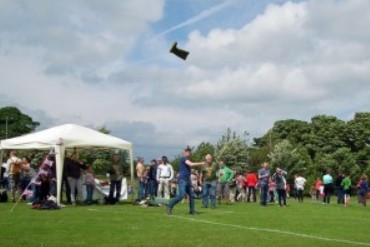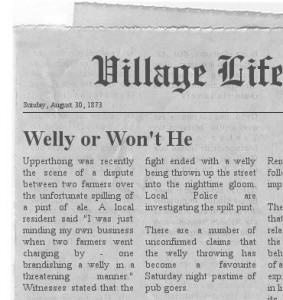Welly Wanging World Championships
The Welly Wanging World Championships are held each year during the Upperthong Gala weekend. There have been a number of pretenders over the years, but the only Official Welly Wanging World Championships are held in the sports birth place – Upperthong Village.
The sport is to be played with the upmost of British sportsmanship and a large smattering of sense of humour. The premise is blindingly simple – all competitors have to do is wang (Yorkshire for throw) a Wellington boot as far as possible within defined boundary lines, from a standing or running start. It’s pretty much the same as the javelin event in the Olympics with the exception that a welly is unlikely to ever skewer an unexpecting judge or spectator.

Rules
Welly Wanging has grown as a gala, fete and summer fair sport over the years. Despite the casual, friendly and sporting manner in which it is played – a high level of competition has evolved. This has led to to precise and documented rules for the sport in an attempt to ensure it is played fairly and consistently.
Of course, we recognise that rules go against the very nature of the sport and are a smattering of common sense should always be used when interpretting them. The rules of Welly Wanging as ratified by the World Welly Wanging Association are listed below.
- Welly wanging is a sport open to all people irrespective of age, sex, race, creed, religion, nationality and colour. And people from Lancashire.
- The sport shall be a civilised affair. Fair play, good humour and good manners shall be exhibited at all times.
- No umpire shall be needed. A player’s word and their honour shall be sufficient.
- Distances shall be measured in yards, feet and inches. None of this European nonsense.
- The standard welly shall be the Dunlop green, size 9, non steel toe-cap. Competitors shall select whether they use left or right welly.
- No tampering with the welly shall be allowed. Factory finish only. No silicone polish is to be applied.
- A maximum run-up of 42 paces shall be allowed. This distance was chosen in memory of Douglas Adams, himself a proponent of the sport.
- The run-up shall end with a straight line of 10 feet in length, that being the width of a standard Yorkshire gate.
- The welly shall land within the area defined by the straight lines between the Upperthong Gala field and Holme Moss television mast on one side, and on the other by the line between the field and Longley Farm windmill. This playing area is known as the ‘Thong’.
- There shall be four categories: Men’s and Women’s, and Boys and Girls (u-14’s).
- The welly shall be projected using any action of the arm or foot for the respective categories.
- The use of wind assistance is allowed and, indeed, encouraged. Waiting for a suitable gust, however, is limited to one minute. No artificial or man-made wind is to be used.
- The winners of the two adult categories at the World Championships shall receive a trophy and respect from all Welly Wangers across the world. Winners of the Children’s category shall receive a crisp five-pound note. They can spend this on anything they like.

2014 Welly Wanging World Champs
Men – Adam Taylor
Ladies – Rebecca Locks
Girls (u14) – Bethany Casson
Boys (u14) – Joe Mitchell
2013 Welly Wanging World Champs
Men – Adam Taylor
Ladies – Annie Mitchell
Girls (u14) – Amy Broomhead
Boys (u14) – Sam Hobson
2012 Welly Wanging World Champs
Men – Tim Nield
Ladies – Pauline Hazleden
Girls (u14) – Amy Broomhead
Boys (u14) – Sam Hobson
2011 Welly Wanging World Champs
Men – Joshua May
Ladies – Rebecca Ferrington
Girls (u14) – Judy Graham
Boys (u14) – Paul Johnston
Throwing Techniques
There are quite a few techniques for throwing a perfectly good welly. Some are next to useless e.g. flicking it off the end of your leg – best leave this technique for when you come in from a hard day in the garden. Some generate a surprisingly amount of power e.g. the over head throw that when done correctly leaves you slightly dizzy. Widely accepted techniques for ensuring good welly velocity are listed below :
- One handed – This is a commonly used technique, where the competitor uses a single hand to wang his or her welly. This can be attempted either right or left-handed, but you cannot use both simultaneously on separate boots – that would be pretty stupid.
- Double handed – This is often used where there is a particularly large welly, so that both hands can fit securely around the boot. Propulsion in this position usually involves a shot-put-style swing technique. The challenge with this technique is managing to maintain accuracy whilst pursing maximum velocity.
- Between the legs – This is where the competitor throws the welly from between their legs, facing towards the target and bending the legs slightly to accommodate the swing. This is a commonly applied technique for smaller competitors and beginners. Not a good idea for anyone with a dodgy back.
- Backward throw – This is when the competitor throws the welly over their head, whilst facing away from their target. Whilst this enables a large back swing, it also means that the target is out of sight for the duration of the throw. The competitor must also be wary of having the boot land on their head when throwing in this position – but only if they have the intelligence of a slug and let go of the welly too early.
World Records
According to the Guinness Book of World Records the furthest Welly Wanging throws were set at Hämeenlinna, Finland, on 12 October 1996. The measured throws were :
Men – 63.98m by Teppo Luoma (Finland)
Women – 40.87m by Sari Tirkkon (Finland)
Pretty impressive distances I’m sure you’ll agree!
History of Welly Wanging
Welly Wanging originated in Upperthong at a time when people didn’t have the distraction of PlayStations, shopping or watching TV to while away the time. So people had to be inventive and create games around the everyday objects they had at their disposal. Being a rural village, Upperthong folk didn’t have a great deal of stimulation to work from so it’s no surprise that our recent ancestors discovered an alternative use for the most popular footwear in the village – the Welly Boot.
History has it that the sport originated from a spat between two farmers in the local pub one night. An unfortunate incident saw the spilling of ale into the wellington boot of an innocent and unwitting bystander. Notwithstanding the virtual criminal act of spilling ale in the first place – something that would almost certainly have caused a chorus of boos, hisses and well deserved verbal abuse directed at the clumsy oaf. The farmer whose trousers were now sodded and whose foot was drowned up to the ankle was not best pleased by all accounts. In a fit of rage he removed his boot and preceeded to chase the drink spilling fool out of the pub swinging hard and fast with his improvised rubber weapon.
Unfortunately, with only one boot he was considerably slower than his prey. And so in a fit of frustration he wanged the boot as hard as he could in the direction of the faster farmer. It’s unclear whether he missed or managed to clonk the chap on the back of the head.

local newspaper.
There is some evidence to suggest that locals re-enacted the scene over the following weeks. And that this somehow turned into a friendly competition as to who could throw the welly most like the angry farmer – who threw it a long way apparently. From that point on Welly Wanging made it into Upperthong village life and then upwards and onwards onto the global stage.
It’s All About The Boot
The Wellington Boot has enjoyed a long and successful existence – rising from a purely agricultural application to being the default footwear for festival goers and even to the decadent heights of modern fashion and catwalk exposure !! Rather than repeat its history here, please pop over to Wikipedia and check it out for yourself….


